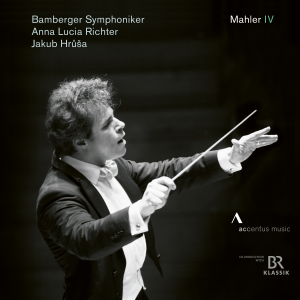
ESSENTIAL RECORDINGS

When the Bamberg Symphony and their principal conductor Jakub Hruša went on tour in Germany with Mahler's Fourth Symphony in January 2020, no one would have thought that this symphony in particular would become a kind of "symphony of fate" of the year, for only two months later, the performance of major symphonic works was impossible for a long time after the "corona lockdown" in Germany, which hit cultural institutions particularly hard. The Bamberg Symphony were involved at an early stage in investigating the effects of making music together on the spread of the virus and helped to develop concepts for safe concert performances. This enabled their renowned Mahler Competition to take place in early July 2020, with Mahler's Fourth Symphony at its center. Even though it is the smallest Mahler symphony, these were the first symphonic performances after months, which then led to one of the first symphonic album recordings in times of the pandemic - seated apart, but musically closer than ever. {Accentus Music}
The opening movement of Gustav Mahler's Symphony No. 4 in G major is a portrayal of heaven on earth which is nature in all its forms, including flowering meadows, animals, birds, fish and even frogs, before the intrusion of man. Various individual instruments play the role of these creatures, therefore clarity and distinctiveness of orchestration details are paramount to its ability to strike home. This is all very well achieved under the direction of conductor Jakub Hruša whose previous recommended recordings include the music of Martinu, Smetana and Dvorak. In particular, the horn section of the Bamberg Symphony Orchestra needs to be singled out for its crisp and articulated delivery in certain passages, as well as the audio recording itself which realistically positions the horn players in the back of the orchestra. I'm beginning to wonder if the socially distant seating arrangement may have something to do with the sonic details. At the 6:15 mark Pan himself appears, represented by the flute, and summons all living creatures to partake in the joy of life, until man suddenly makes his entrance at the 9:55 mark with the same foreboding and ominous trumpet call which opens the Fifth Symphony. The mood of the movement is altered at this point, until (and Hruša captures this very well) at the very end, albeit relunctantly, everyone joins together to cap the movement in blissful exuberance.
The following Scherzo movement was originally headed (Friend Hein Strikes Up). Hein was a sinister figure in German folklore, sort of like a pied piper, who led his followers to the land of the dead. Sort of like a children's version of the Grim Reaper, and the grotesque, slighty off-key solo violin depicting the character is perfectly done here, especially when it lulls the children to sleep into a distorted and deceptive dreamscape.
And of course, what comes next is one of Gustav Mahler's most personal statements, in the form of a Ruhevoll, poco adagio (peacefully, slow) movement which basically encapsulates the innocence of childhood as seen through the eyes of an adult witnessing the loss of freedom and innocence. And it wouldn't be typical Mahler music without moments of great anxiety and disquiet (Did you know that Mahler's inspiration for this was of a vision of a tombstone with a carved image of someone in eternal sleep?). And what makes this version of this movement particularly impressive comes at the very end around the 18:45 mark, after heaven's gates have opened up to reveal it's brilliant light, and the sound of the orchestra becomes so light and airy as to become diaphanous and translucent.
The final movement is when mezzo-soprano Anna Lucia Richter steps in to sing the text based on a Wunderhorn poem about the beatitudes of infinite varieties of food in heaven, including apples, bread, lamb, hares, etc ... The magical moment arrives near the 5:10 mark when the mood shifts, when the tempo relaxes into that wonderful cradle like rocking, when the notes descend into a lower register, and the violas take over the melody, very well done in this recording, and Richter's beautiful voice exudes the content and blissful state of heavenly life. Highly recommended!
Jean-Yves Duperron - January 2021